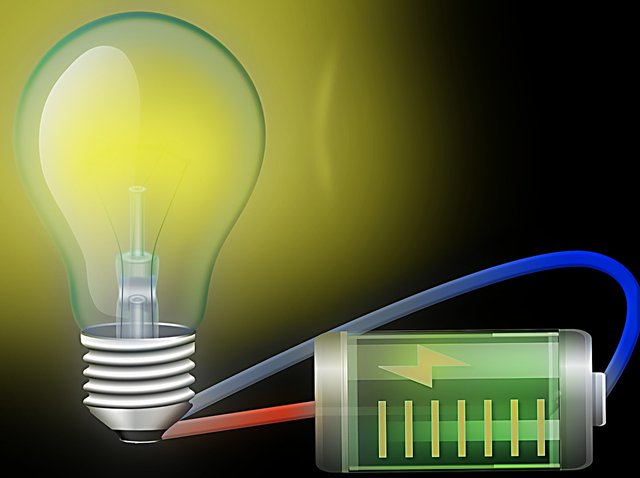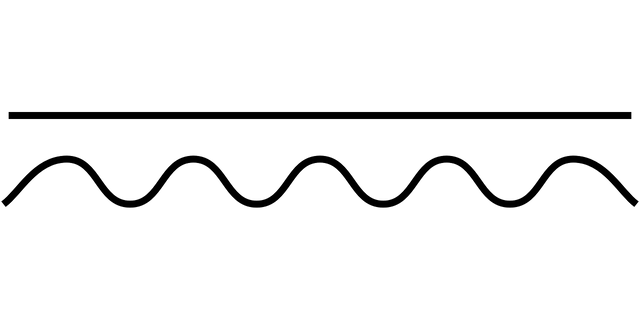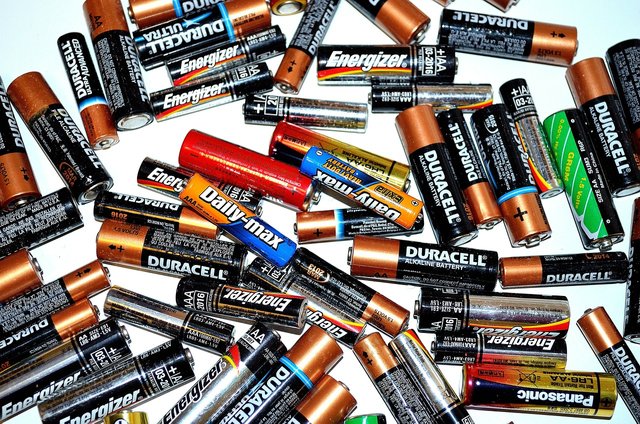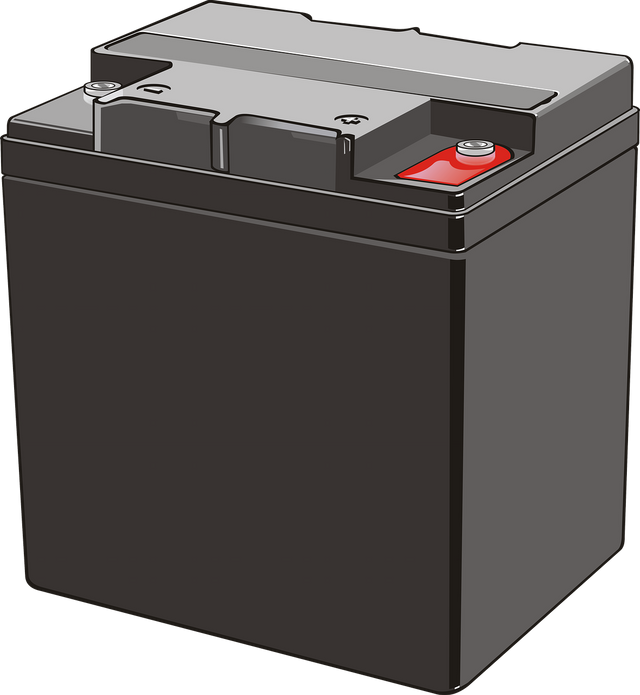BATTERIES: The Link Between Alternating Current & Direct Current
Hello Steemians, I welcome you once again to my blog. Recently, I have been writing on Power systems, explaining how forms of energy are being converted for production of electricity.
I sincerely appreciate the comments and feedbacks on the previous posts which made them an interesting and interactive one, and I'm glad people could learn so well from the Posts.
Regarding the previous posts, we have learnt how power is generated via the conventional way by the use of generators coupled with different sources providing the mechanic power towards power generation and the alternative ways such as Solar energy, wind energy and other sources of renewable energy. This post will further buttress electricity production focusing on alternating and direct current form of power supply alongside the use of batteries as a source of power.

Image Credit: Pixabay Commons
Power is generated from these forms of energy either as alternating current (AC) or direct Current (DC) with a high or low voltage value. Going by the conventional way of generating power, generation of power in an alternating current (AC) comes quite easy with generator design. It also comes more economical generating power in an alternating current and the fact that alternating current can be easily step up/down during the process of power transmission makes power generally produced in alternating current form. In the other hand, production of power in direct current (DC) comes with certain disadvantage but definitely has its own way of being good.
 AC & DC waveform.[CC0] , from Pixabay Commons
AC & DC waveform.[CC0] , from Pixabay Commons Before moving on, let me quickly in a simple way describe alternating current as the power source in which there is a change in the direction of electron flow i.e. alternate in direction, taking a sinusoidal waveform (sine wave) while direct current is the power source in which electron flows in one direction i.e. in a steady way. Both forms of power are ways in which electricity can be produced.
Transmission of power in direct current especially at high voltage level pose serious threats to engineers as this voltage level of dc cannot be easily stepped up/down. Power is being consumed as generated, certainly the need for power transmission to the level of distribution is required. Transmitting power at high voltage direct current (HVDC) requires costly and technical equipment, effective transmission line maintenance, other than the difficulties in transforming the voltage. However, high voltage direct current (HVAC) are found to have less energy loss during power transmission, also less insulation is required and gives a greater reliability as compared to high voltage alternating current (HVAC).
With the alternative or unconventional way of generating electricity, solar energy for example, one of renewable sources in which solar power system is harnessed from, provides a direct current form of power. If you read through this post, you will have an idea of how solar power system works. But just a little one here, Solar Power system works basically by the use of photovoltaic modules to collect solar irradiance which thereby converts to direct current by presence of silicon cells and other elements that make up the module to perform the effect of photoelectric.
The harvest from the photovoltaic modules gives a direct current (DC) form of power but household or residential buildings and offices are mostly of alternating current (AC) outlet because of the relative advantages of generation and transmission of alternating current as mentioned earlier. Thus, a need to convert the direct current from solar power to useable alternating current is required which the inverter as a part of components of solar power does.

From the lesson so far, we've basically learnt how the conventional and the unconventional ways of generating power works by giving us either an alternating current (AC) or direct current (DC) form of power supply. Now I believe I can introduce you that very critical component making energy or Power received in form of a direct current available at all time. Will you try guess? I mentioned it earlier though. It's simply the Battery
Battery is such a very unique component that has enhanced the production and usage of power providing a medium of conversion of chemical energy into electrical energy. A battery is a medium containing cells and other materials for the conversion of chemical energy to electrical energy.
Batteries play a very important role serving as storage devices. You may like to call it a power bank, which is definitely what it is. But not just that, don't you think batteries are actually what provides us a way of storing our direct current form of power, also a way of storing alternating current in form of direct current as well.
Okay! Let me make myself clear; From the alternating current outlet at home, we make use of alternating current to power charger adapters for gadgets such as mobile phones or laptop computers, but these devices actually works with direct current. The adapters rectifies the alternating current to direct current which powers the appliances. Battery is what thereby comes in as a medium in which direct current is made available by storing direct current charges for later use as found in mobile set and other devices for backup.
Similarly, in the case of Solar power system, batteries plays their role serving as power bank by storing directly the direct current generated by the photovoltaic modules. Think of a solar power system without batteries, definitely no way of getting the energy stored not to talk of converting to an alternating current form of supply. Battery does well with their function in solar power system and other forms of power generation in dc form by making power available, storing direct current for continuous use and providing when needed.
 Primary Batteries.[CC0] , from Pixabay Commons
Primary Batteries.[CC0] , from Pixabay Commons Batteries are classified as primary and secondary: the primary being the non rechargeable type in which the chemical substance are in-built. Example is the Daniel cell, Leclanche cell etc. while the secondary are the rechargeable type in which requires an external source for energy to be induced in the chemical substance. Example of secondary type of batteries include the nickel-iron batteries, the Lead-acid batteries etc.
 Secondary Battery.[CC0] , from Pixabay Commons
Secondary Battery.[CC0] , from Pixabay Commons With emphasis on the secondary type of batteries, they are generally classified based on their application or use, mostly made of lead-acid containing a medium of sulphuric acid and metal plates made of lead to store electric charges through chemical process.
Starting Lighting Ignition (SLI) or automotive batteries and the Deep Cycle batteries are the major classifications of secondary batteries.
Starting Lighting Ignition (SLI) batteries are one which are designed to produce a burst of current for a short time for lighting or ignition purpose. These are types of batteries found in vehicles for cranking the engine while deep cycle batteries are one designed to store large amount of energy. They can be deeply discharged and are built with very good cycling capacities. Deep cycle batteries are types of batteries found for industrial use (as stand-by in power system and telecommunications), and also found mostly in use and suitable for solar power system.
The classification of secondary batteries makes the type of batteries application specific. Let's take for instance: A Starting Lighting & ignition (SLI) battery has it's application just to provide large current for a short time for ignition in vehicles start-ups and continue the recharging process with power supplied by the vehicle alternator. It cannot be used in place of deep cycle batteries as it is designed just to release current for start-ups as the name has indicated.
There is this myth people have when it comes to batteries in solar-power system; the use of the so-called 'Trailer Batteries' as the type of battery used in solar power system. Trailer batteries as most will call it are just a type of SLI batteries which do not fit into solar power system application. Well, I'm glad to inform you that deep cycle are the batteries used in solar power system which are designed to provide power in a steady rate for a longer duration and capable of being deeply discharged, also providing a great run time unlike the starting lighting Ignition ( SLI) batteries. Using the automotive batteries in place of deep cycle doesn't end well but only appears to get the battery compromised within a short time.
BATTERY CAPACITY AND RATING
The gauge or scale at which a battery can store and deliver power to a load, given at a specified rate of discharge simply defines a battery capacity. The capacity of a typical battery however depends on certain factors including the density of electrolyte (capacity increases with density), temperature (high temperature cause an increase in capacity of battery cell), rate of discharge (battery capacity decreases as rate of discharge decreases) and the quantity of material present determines a battery capacity.
Battery capacity is determined and rated at a specified discharge rate (an industrial standard period of time). The capacity of batteries are mostly measured in Ampere-hour which is determined by how much a battery can deliver over a standard period of time (Most often at 20hr rate).
Let's assume a battery with @20hrs rate. The battery is continuously discharged for 20hrs, delivering 5Amps of current. Hence, the battery is rated 100AH
In the same vein, a battery rated 200AH @20hrs rate will deliver 10amps of current for 20hrs before the battery gets low. i.e.
Discharge time (hrs) = AH Rating/continuous current (Amps)
200AH/10amp = 20hrs (discharge time)
BATTERY CHARGING
One of the very fast way to get batteries compromised is improper charging. As much as a battery can be of a good quality, if subjected to improper maintenance, the battery will live a very short life. In my previous post, I talked about the importance of solar charge controllers in serving as a smart charger for batteries, providing an intelligent charging action. The solar charge controller regulates the flow of charge going to the battery in an automatic and intelligent way, simply keeping the battery in a good state.
Charging batteries with other external sources like inverter or external chargers that rectifies alternating current to direct current to charge the battery also incorporate a system of charging which makes battery charging smooth and gives effective charging thereby keeping the battery in a good state.
Inverters and external chargers incorporates the Three stage Charging Process to determine the type of charging stage to apply to batteries during the charging cycle.
• Bulk Charging: This is the first stage of the charging process, it is a stage where most of charging activities takes place. This stage supplies a constant current to charge the battery which holds up to 80℅ of the battery charge.
• Absorption Charging: This is the second stage of the charging process. When battery gets to this stage, the chargers intelligently lowers the current having charged up to 80℅ in the bulk stage and provide a constant voltage maintaining the charging process to about 98℅.
• Float Charging: This stage is the one which takes over from the absorption stage. Here, the voltage level is further dropped bringing the battery from 98℅ charge to 100% charge. This stage also maintains the battery at a 100℅ charge.

These 'three stage charging' process are methods employed in solar charge controllers and chargers which charges the battery to provide effective charging and maintaining the battery cycles.
I hope I'm able to impact some more this time again. Till I come your way next time. Thanks for reading through!
REFERENCES
If you write STEM (Science, Technology, Engineering, and Mathematics) related posts, consider joining #steemSTEM on steemit chat or discord here. If you are from Nigeria, you may want to include the #stemng tag in your post. You can visit this blog by @stemng for more details. 
I'm a proud member of @promo-mentors where you get mentored and guided on how to make quality posts on steemit amongst other benefits. Do join us on discord. We anticipate your arrival.

The batteries are very important and should be taken care of.. I once saw on my phone trickle charge when the battery is almost full what does it mean?
There you have it, trickle charge is same as float charge. It's the third charging stage where volatge and current are further reduced and held constant to maintain your battery in a fully charged state.
Congratulations @olajidekehinde! You have completed some achievement on Steemit and have been rewarded with new badge(s) :
Click on the badge to view your Board of Honor.
If you no longer want to receive notifications, reply to this comment with the word
STOPTo support your work, I also upvoted your post!
Do not miss the last post from @steemitboard!
Participate in the SteemitBoard World Cup Contest!
Collect World Cup badges and win free SBD
Support the Gold Sponsors of the contest: @good-karma and @lukestokes
Batteries have been very useful when there is need to store electric power fo future use. the effective use of the batteries in the solar power system is not debatable as the sun cannot be up 24/7.
in recent times, the batteries are getting smaller. hopefully, we would have even smaller and more efficient batteries in the nearest future
I once saw my phone charge till 106% does it signify a bad battery or bad current entering it?
That should be an error within the phone or probably a defective charger was used in the process.
Thank you very much for this exposition. What about a situation, which is quite common, where one uses a charge with a bit higher voltage output on a battery, surely this will shorten its life but what happens between its cells?
Definitely this action will have an effect on the battery cells. The cell plates get compromised applying much voltage than required for charge.
Hi @olajidekehinde!
Your post was upvoted by utopian.io in cooperation with steemstem - supporting knowledge, innovation and technological advancement on the Steem Blockchain.
Contribute to Open Source with utopian.io
Learn how to contribute on our website and join the new open source economy.
Want to chat? Join the Utopian Community on Discord https://discord.gg/h52nFrV
A lot to learn from this expository post. Especially about the charging stages of those batteries.
One question though, WHATBIS the technology behind those fast charging phones (they also say they are flash charging)
Good question, A charger designed with an intelligent charging algorithm would deliver a fast charge to the battery. Also, there are some charging algorithm design built in the phone alongside, to make up this effect.
What if I told you I never knew batteries had classification? I used to think one used for vehicles could also work for solar or even generators. Good post. Got an ample idea on battery already!
Thanks, I'm glad you found this educative.